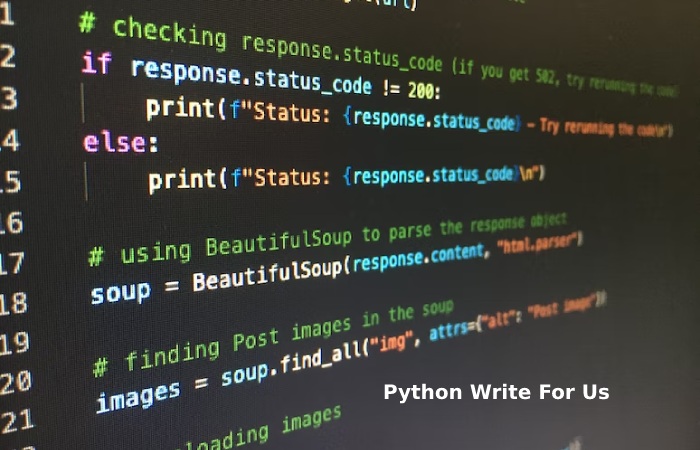Python Write For Us – Python is not known for being a “fast” programming language. However, according to the 2020 Stack Overflow Developer Survey Results, Python is the 2nd most popular software design language behind JavaScript (as you may have guessed). This is mainly due to its super-friendly syntax and applicability to almost any purpose. While Python isn’t the fastest language, its excellent readability, attached to unrivalled community support and library availability, has made it extremely attractive for doing things with code.
Python’s memory management also plays a role in its popularity. How is that? Python’s memory management is implemented in a way that makes our lives easier. Have you heard of Python’s memory manager? The manager keeps Python’s memory in check, allowing you to focus on your code without having to worry about memory management. Due to its simplicity, however, Python doesn’t give you much freedom in managing reminiscence usage, unlike languages like C++, where you can physically allocate and free memory.
However, having a good understanding of Python’s memory management is a great start to allow you to write more efficient code. Ultimately, you can enforce it as a custom that can be adopted in other software design languages you know.
So what do we get by writing memory-efficient code?
Python Write For Us
- The nice thing about writing code that is memory efficient is that it doesn’t necessarily require more lines of code to be written. It leads to faster dispensation and less need for capital, specifically random access memory (RAM) usage. More available RAM would generally mean more cache space, which will help speed up disk access.
- Another benefit is that it prevents memory leaks, a problem that causes RAM usage to continuously increase even when procedures are killed, eventually leading to slowdowns or deteriorating device performance. This is caused by the inability to free used memory after processes have terminated.
In the world of technology, you may have heard that “done is better than perfect.” However, let’s say you have two developers who have used Python to develop the same application and have completed it in the same amount of time. One has written more memory-efficient code, resulting in a faster application. Would you choose the app that runs smoothly or the one that runs noticeably slower? This is a good example where two individuals would devote the exact total of period coding and yet have noticeably different code performances.
This is what you will learn in the guide:
- How is memory managed in Python?
- Garbage Collection in Python
- Memory monitoring in Python
- Best practices to improve code performance in Python
How is memory managed in Python?
Rendering to the Python (3.9.0) documentation, Python’s memory management includes a private heap used to store your agenda’s objects and data constructions. Also, recollect that the Python memory boss does most of the dirty work related to memory organization, so you can only focus on your code.
Memory allocation in Python
Everything in Python is an object. For these substances to be helpful, they need to be stowed in memory to be accessed. Beforehand they can be stored in memory; a chunk of reminiscence must first be owed or allocated for apiece of them.
At the lowermost level, Python’s raw reminiscence allocator will first ensure that space is available on the private heap to store these objects. It does this by interacting with your operating system’s memory manager. Think of it like your Python program asking the working plan for a chunk of memory to work with.
At the next level, several object-specific allocators function on the same heap and tool different management rules contingent on the object type. As you may already know, some object types are strings and integers. Although strings and integers may not be that different when you consider the time it takes to recognize and memorize them, computers treat them very differently. This is because computers have other storage requirements and speed tradeoffs for integers compared to strings.
One last thing to know about how the Python heap is managed is that you don’t have any control over it. Now you may wonder, how do we write memory-efficient cyphers if we have so little switch over Python’s reminiscence running? Beforehand we get into that, we need to understand some important terms regarding memory management better.
Static memory allocation vs dynamic
Now that you understand what memory distribution is, it’s time to familiarize yourself with the two types of reminiscence allocation, static and dynamic, and distinguish between them.
Static memory allocation:
- As the word “static” suggests, statically assigned variables are permanent, meaning they must be set beforehand and last as long as the program runs.
- Memory is allocated at compile time or before program execution.
- It is implemented using the stack data structure, which means variables are stored in the stack’s memory.
- Memory owed cannot be recycled, so there is no memory reuse.
Dynamic memory allocation:
Python Write For Us
- As the word “dynamic” suggests, dynamically assigned variables are not permanent and can be given while a package runs.
- Memory is allocated at runtime or during package execution.
- It is implemented using the heap data structure, which means that the variables are stored in the heap’s memory.
- Memory that has been allocated can be freed and recycled.
One benefit of dynamic memory allocation in Python is that we don’t have to worry about how many reminiscences we need for our program beforehand. Another gain is that data structure handling can be done freely without consuming worry of needing more memory allocation if the data structure expands.
However, since the dynamic memory distribution is done during program execution, it will take more time. Also, the reminiscence that has been allocated needs to be freed afterwards it has been used. Otherwise, the issues like memory leaks can occur.
We came across two types of memory constructions earlier – heap memory and stack memory. Let’s take a deeper appearance at them.
stack memory
All devices and their variables stored in stack memory. Remember that heap memory allocated throughout amass time? This efficiently means that admission to this type of reminiscence swift.
When a method is named in Python, a heap frame is assigned. This stack frame will handle all the method variables. After the method returns, the stack frame is automatically destroyed.
Note that the stacking frame is also responsible for setting the scope of a method’s variables.
heap memory
All instance objects and variables stored in heap recall. When a variable shaped in Python, it stowed in a secluded heap, allowing it to allocated and deallocated.
Heap memory allows these variables to be accessed globally by all methods of your program. Once the variable is returned, the Python garbage collector goes to work, which we’ll cover advanced.
Today let’s take a look at Python’s memory construction.
Python has three different heights when it comes to its memory structure:
- sands
- Pools
- blocks
We will start with the biggest of all: the arenas.
sands
An arena signifies the most significant possible chunk of reminiscence. Imagine a desk with 64 accounts covering its entire surface. The top of the desktop represents an arena with a fixed size of 256KiB allocated on the heap (Note that KiB is different after KB, but you can assume they are the same for this clarification).
More precisely, nas memory mappings that rummage-sale by the Python allocator, by malloc, which enhanced for small objects (less than or equal to 512 bytes). The arenas allocate memory, so subsequent builds don’t have to do it anymore.
This arena can be divided into 64 pools, the next most extensive memory construction.
Pools
Going back to the desk example, the records represent all the pools within a stadium.
Each pool would typically consume a fixed size of 4Kb and can have three conceivable states:
- Empty: The collection is open and, therefore, available for allocation.
- Used: The collection contains objects that make it neither empty nor full.
- Complete: The collection is entire and, therefore, not available for any other distribution.
Note that the scopegroup should agree with the default reminiscence page size of your working system.
A group then divided into many blocks, the minor memory structures.
blocks
Going back to the desktop example, the sheets within each book signify all the blocks inside a pool.
Unlike stadia and pools, the size of a lump is not immobile. The size of a block goes from 8 to 512 bytes and must be a manifold of eight.
Each block can only hold one Python object of a given size and has three possible states:
- Untouched: Has not assigned
- Free: Has given but was released and made available for assignment
- Assigned: Has assigned
Note that the three levels of reminiscence construction (sands, pools, and blocks) we discussed earlier are specifically for smaller Python objects. Large objects absorbed into the standard C allocator inside Python, which would a decent read for an additional day.
Python refuse collection
Garbage collection a course carried out by a package to free memory previously allocated for an object that no longer in use. You can think of garbage allocation as recycling or reusing memory.
Previously, programmers had to allocate and deallocate memory manually. Forgetting to deallocate memory could lead to a memory leak, leading to a drop in execution performance. Worse, manual memory allocation and deallocation are likely to lead to accidental memory overwrites, which can cause the package to crash altogether.
In Python, garbage collection done mechanically and thus saves you a lot of headaches in manually managing memory distribution and deallocation. Specifically, Python uses reference counting joint with generational garbage collection to free unused memory. Reference counting alone isn’t enough for Python because it doesn’t effectively clean up dangling cyclic orientations.
A generational garbage collection cycle covers the following steps –
- Python initializes a “discard list” for idle objects.
- An algorithm executed to detect reference cycles.
- If an object lacks external references, it inserted into the drop list.
- The memory allocation for the objects in the drop list is freed.
To learn more about garbage groups in Python, you can refer to our Python Trash Collection: A Guide for Developers post.
Monitoring memory problems in Python
Although everyone likes Python, it not spared from memory problems. Here are many likely reasons.
Rendering to the Python (3.9.0) certification for memory management, the Python memory manager doesn’t necessarily release memory back to your operating system. The documentation states, “under certain circumstances, the Python reminiscence manager may not trigger appropriate actions, such as garbage collection, memory compaction, or other preventative events.”
As a result, one may have to openly access reminiscence in Python. One way to do this is to power the Python trash collector to free up unused memory using the GC module. To do this, just run GC. collect(). However, this only provides noticeable benefits when handling a large number of objects.
Python Write For Us
Aside from the occasionally buggy nature of the Python garbage gleaner, especially when dealing with large data sets, various Python libraries also known to cause memory leaks. Pandas, for example, are one of these tools on the radar. Consider looking at all the memory-related issues on the official pandas GitHub repository!
One apparent reason that may go unnoticed by even the keen judgements of code reviewers that large objects lingering within the code not released. On the same note, infinitely rising data structures are another cause for concern—for example, a growing dictionary data structure with no fixed size boundary.
One way to solve the growing data assembly is to convert the dictionary to a list, if possible and set a maximum size for the list. Otherwise, just put a limit on the size of the dictionary and clean it every time the limit touched.
Now you may be speculating, how do I detect memory problems in the first place? One choice is to use a request performance nursing (APM) tool. Also, many helpful Python modules can help you track down and locate memory problems. Let’s expression at our options, preliminary with APM tools.
Application Performance Monitoring (APM) Tools
So what exactly is application performance nursing, and how does it help track down memory issues? An APM tool lets you detect a program’s real-time performance metrics, allowing continuous optimization as you discover problems limiting presentation.
From the reports generated by the APM tools, you will get a general idea about the performance of your program. Since you can receive and monitor performance metrics in real time, you can take immediate action on any practical issues. Once you’ve narrowed down the possible areas of your program that may be to blame for reminiscence issues, you can formerly dive into the code and deliberate it with the other code donors to further control the specific lines of code that essentially fixed.
Tracing the root of memory leak problems itself can be an intimidating task. Fixative s another nightmare, as you need to comprehend your code. If you ever find yourself in that location, look no further because ScoutAPM is a handy tool that can usefully analyze and optimize your request’s presentation. ScoutAPM gives you real-time vision so you can quickly locate & resolve issues before your customers can detect them.
profile modules
You can use many helpful Python modules to solve memory problems, whether a memory leak or your program crashes due to excessive memory usage. Two of the recommended ones are:
- trace malloc
- memory profiler
Note that only the trace malloc module was is built-in, so install the other module if you want to use it.
trace malloc
Rendering to the Python (3.9.0) certification for trace malloc, using this module can give you the following information:
- Return where an object was assigned.
- Statistics on memory blocks allocated by file name and line number: total size, number and the average size of memory blocks given.
- Calculate the difference between the two snapshots to detect memory leaks.
A recommended first step to determine the source of your memory problem is to display the files that allocate the most memory. You can effortlessly do this using the first code instance exposed in the documentation.
However, this does not mean that files that allocate a minor amount of memory will not grow forever to cause memory leaks in the future.
memory_profiler
This module is fun. I’ve worked with this, and it’s a personal favourite because it allows you to add the @profile decorator to any function you want to investigate. The resulting output is also straightforward to understand.
Another reason this is my favourite is that this module allows you to plot a memory usage graph based on time. Sometimes you need a quick check to see if reminiscence usage keeps increasing indefinitely. This is the perfect answer, as you d, don’t need to do a line-by-line memory profile to confirm it. You can look at the plotted graph after letting the profiler run for a long time. Here is an example of the chart that comes out

Likewise, You can submit your articles at contact@technostag.com
How to Submit Your Python Articles (Python Write For Us)?
That is to say, To submit your article at www.Technostag.com, mail us at contact@technostag.com.
Why Write for Technostag – Python Write For Us
Python Write For Us
That is to say, here at Technostag, we publish well-researched, informative, and unique articles. In addition, we also cover reports related to the following:
high-level,
general-purpose programming language
code readability
significant indentation
dynamically-typed
garbage-collected
programming paradigms,
structured
procedural
object-oriented
functional programming
standard library
Guido van Rossum
ABC programming language
Guidelines of the Article – Python Write For Us
Search Terms Related to [Python Write For Us]
programming write for us
ai write for us
javascript write for us
write for us we pay
[write for us lifestyle]
[write for us health]
courses write for us
honeybadger write for us
write for us + business
write for us + fashion
health want to write for
[“write for us” + lifestyle]
[write for us + General]
[write for us + technology]
health niche write for us
engineering write for us
Related Pages
Gadgets Write For Us
Machine Learning Write For Us
Digital Marketing Write For Us
Anti Virus Write For Us
Gaming Write For Us
Hacking Write For Us
Smartphone Write For Us
Web Design Write For Us
Big Data Write For Us
Cloud Computing Write For Us
Software Write For Us
VoIP Write For Us
Data Center Write For Us
Computer Write For Us
5G Write For Us
CCleaner Write For Us
CRM Write For Us
Analytics Write For Us
Data Science Write For Us


